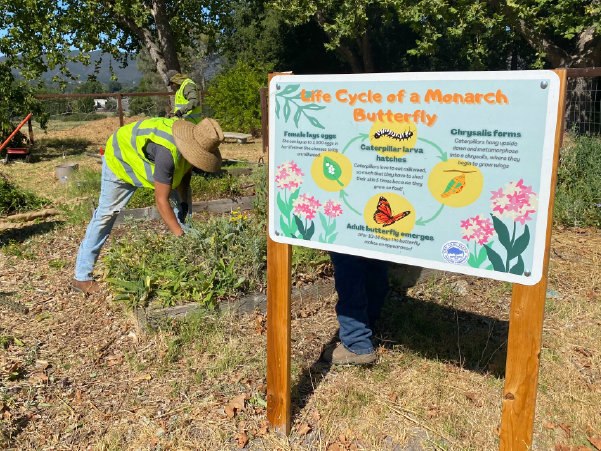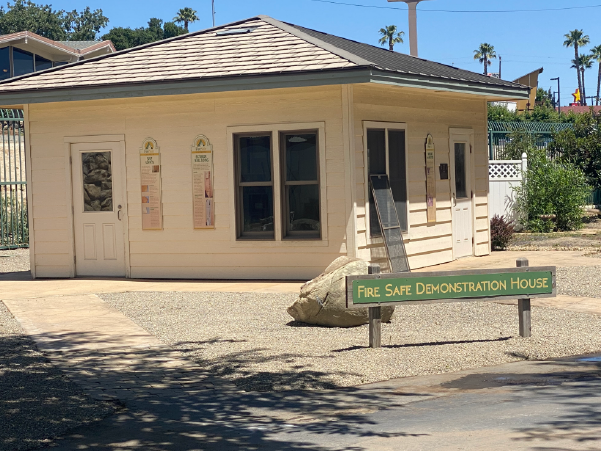
Aug 19, 2021
Late in 2019, Madrone partnered with One Cool Earth, a non-profit organization that creates garden-based school programs. We committed crews to improve and maintain gardens at six Atascadero School District schools. Shortly after our discussion, the entire program was put on pause as schools employed health and safety measures.
As kids head back to campus this month, Madrone has been busily preparing the outdoor classroom sites. Our team worked on each garden used for One Cool Earth’s Earth Genius program, rejuvenating and preparing the sites for a new school year. From mulching and weed abatement to repairing hardscape, we spent a few days ensuring that each school can rely on a garden space that will enrich them throughout the year. One Cool Earth educators can now visit each week and rely on a revitalized garden to teach about nutrition and the environment.
Madrone and One Cool Earth share and reinforce one another’s values: giving back, stewardship, and innovation. We look forward to a long and fruitful relationship.

Jul 22, 2021
This is a state-of-the-art irrigation valve manifold installation for Hotel SLO to supply irrigation for planters on 5 levels from ground level to balconies to roof.

Evan Moffitt
Evan Moffitt, CLT, CLIA, PCA, at SiteOne Landscape Supply, has been working with Madrone for over four years, delivering everything from irrigation and pavers to lighting. Evan and SiteOne are reliable partners for anything we might need for our landscapes, assisting us on over one hundred projects for varying clients and spaces.
SiteOne offers a comprehensive selection of top-brand landscape supplies, from irrigation to lighting, throughout North America. “We carry nearly everything Madrone would need, so it’s about getting what they want,” said Evan. After so long working together, we know exactly how they deliver, and they know what we order. Being able to count on their services has come as a huge boon time and time again.
When it comes to philosophies we share, we both work hard to deliver our services on time, valuing urgency and good communication when it comes to others’ time and work. “We understand each other very well,” said Moffitt. “They have a great team culture. A lot of people there work well together, they have a great support and management team to get the projects done, and they communicate well.”
While SiteOne doesn’t always have the opportunity to get out to the site and see the results of their reliable supply, we know our work benefits majorly from their ethics and consistency. We’re grateful for the many years we’ve worked together to develop landscapes of which we’re proud.

Hotel SLO’s planters, on 5 levels from ground level to balconies to roof, are supplied irrigation by a state-of-the-art irrigation valve manifold. See above.

Jul 14, 2021
Achieve the Landscape of Your Dreams Post-Pandemic
2020 saw an upsurge in outdoor redesigns—from businesses to backyards. Outdoor living investments topped the list of spending as everyone reconsidered the value of open-air seating or, for homeowners, a sanctuary.
Due to shutdowns, however, disruptions in supply chains were common and became major 2020 obstacles. Consumer demand then outpaced supply and drove up costs as products took longer and longer to arrive.
The lumber and resin supply chains took a particularly harsh hit. Lumber shortages resulted from dealers cutting back in light of falling demands at the start of the pandemic. Resin shortages were driven by “many resin manufacturers and distributors declaring force majeure on [many resin products]” in light of major storm fronts hitting Texas and the Gulf Coast. With resin being used for plastics, even PVC and sprinkler parts rose in price. A decrease in workers across the board also stunted supply chain flow, as there are fewer truck drivers able to deliver.
As the country opens back up, supply chains are patching, but the builder industry still cannot expect the speed and supply of pre-2020 years. Roger Ramsey from Ewing Irrigation emphasized that “we will not have the luxury of a full supply chain to lean on”—we are still in recovery, and it will take time to return to snap back.
According to Evan Moffitt, CLT, CLIA, PCA, from SiteOne Landscape Supply, however, “this pricing is likely to stick. Pricing structures will change. It appears that there is no end in sight in terms of the shortage” (emphasis added). Because of this, it is essential to expect your landscape to not only potentially take longer but to cost more.
That being said, there are ways to be strategic while still achieving the landscape you want. Here are four tips for property owners to stay on top of limited resources:
Be Flexible
Do not marry yourself to a single ideal, and make sure to have a backup plan. Availability is still limited, and you should plan for the event that your specific materials might not be the best option. Says Ramsey, “Make sure you have an alternate in mind for each part of your project.” Be open to discussion with your designers on whichever aspects might see trouble.
Communicate
Early and proactive communication of your needs will make for a much smoother schedule. Try to be clear about what you need to be done and when, and the business tackling your project will adjust as they are able. Ask for realistic timelines so that you know what you can expect. Be communicative with your vision, needs, and options so you can be accommodated quickly and without fuss.
Be Ready to Switch Gears
Supply chain disruptions are usually sudden and unplanned, which means that your project might not be finished in the expected timeline. If supply shortages make one section of your landscape lag, once again be flexible—encourage the pursuit of other areas of the project site and be proactive with any adjustments you’re ready to accommodate.
Prepare for Price Adjustments
If you’re on a tight budget, begin with a forgiving vision so that you can adjust as needed to any price jumps or extra costs. “Expect delays,” says Moffitt. “Things will take longer to get. Materials will cost more.” Once again, communicate thoroughly with your landscapers so they know what you can and cannot afford. They will adjust within your margins to make sure that any potential hurdles won’t hurt you financially.
Post-pandemic, property owners continue to invest in outdoor spaces, which means not only are materials in high demand, but so is labor. If you are in the midst of a landscape project or planning to start one, these four strategies will guide you cleanly through the process. Please contact us if you have any questions about your project.
“Stay Ahead of Outdoor Living Supply Chain Disruptions,” SLOXpress, CLCA SLO Chapter, April 2021, page 4.

Jul 12, 2021
Learn how to make your landscape defensible during fire season
At Madrone Landscape, we have dealt with properties in high fire danger areas for decades. There are many ways to enhance a property’s defensibility, whether through plant selection and design or irrigation and water system strategies.
Visitors to the 2021 Mid-State Fair in Paso Robles will be able to see for themselves some of these best practices at the Fire Safe Demonstration House for view from July 21st to August 1st. The model property will show strategies for living in fire-prone areas around the Central Coast, especially appropriate as fire season comes upon us.
The multi-phased project will be developed over the next couple of years, and Phase One is getting ready for this year’s Fair. After re-grading, tearing out old plants, and doing a weed abatement, Madrone transformed the space into a simple gravel landscape (one of the best options for fire safety). The open gravel area will accommodate shaded seating, a proposed “Hydration Station,” and educational messaging to help people visualize how they can keep their properties fire-safe. A future phase will feature a mobile multi-media educational exhibit, and the occasional visit by a fire truck.
This community education exhibit was created by the Fire Safe Council, spearheaded by Turko Semmes with Madrone Landscape lending assistance. Semmes and Company built the structure, demonstrating closed eaves and partial straw bale, the latter being three times more fire-resistant than the average material. Also contributing to the fire safe landscaping message is the San Luis Obispo Botanical Garden (SLOBG), whose Fire Safe Demonstration Garden can be viewed daily at the SLOBG grounds off Hwy 1 in San Luis Obipso, near Cuesta College.
Come visit the Demonstration House, a welcome respite from the hot Paso Robles temperatures, featuring shaded seating areas and the only hydration station at the Fair. Bring your water bottle and swing by for a fill-up!

Jul 8, 2021
Rich History and Old-Stock Mission Vines in Our Backyard
Located on 86 acres of the former Milpitas unit of the Hearst Ranch, the Mission San Antonio de Padua features a large church, a museum, and a gift shop. In 2020, as part of the Mission’s ongoing restoration project, we joined the team to complete a renovation of the Mission’s courtyard garden. Working together with Joan Steele, administrator, we were able to create a beautiful garden designed to showcase the many native plants used by the Salinan Tribe. Although the garden is new, these grounds are rich in history (this year marks its 250th anniversary!), and we asked Joan to highlight one of the few original features remaining in the courtyard garden: its original grape stock.

Heritage grape stock cutting purchased through the Mission San Antonio gift shop.
“The cuttings would have been brought either from Mallorca, Spain, in the 1700s and/or from the area around what is now Mexico City,” explains Joan.
The Franciscans knew they would need to plant a vineyard in the New World to have wine for daily Mass. Following construction of the first irrigation system (aqueduct) in California, the Franciscans and the Native Salinan Tribal Members planted the first vineyard on the Central Coast.
They built an adobe wall around the vineyard to keep the animals out and built a house for the “vineyardist” within the vineyard. As the vines flourished, the Franciscans built two large wine vats and a wine cellar (one of the vats and the wine cellar are still visible today as part of the Mission museum). By 1841 there were 4,000 vines in the vineyard.
The Mexican government secularized the Mission in 1834. It was temporarily abandoned in 1844 and the vineyard continued to decline. Prior to his death in 1882, it is believed Fr. Dorothea Ambris moved some of the vines from the declining vineyard and replanted them inside the Mission courtyard and out in front of the Mission to better care for them.
Joan shares that in 2011 the Mission sent samples of these vines to UC Davis for DNA testing. It was discovered that the grapes are “Mission” grapes – also known as Criolla Chica in South America and Pais in France. While this varietal is no longer available in Spain, this type of grape stock is still used widely in Central and South America to produce the local table wines.
“We are very proud of our historic vines, still producing wonderful annual harvests,” Joan notes. “It is one of our long-range goals to reestablish the vineyard at the Mission, using cuttings from the original vines. We hope to engage the cooperation of local university students to rebuild the adobe walls around the vineyard and grow the historic vines for many years to come.”
Currently, the Mission has some cuttings available through the gift shop when it is open on the weekends. Visit www.missionsanantonio.net to keep abreast of the changing schedule due to COVID restrictions and staffing requirements.








